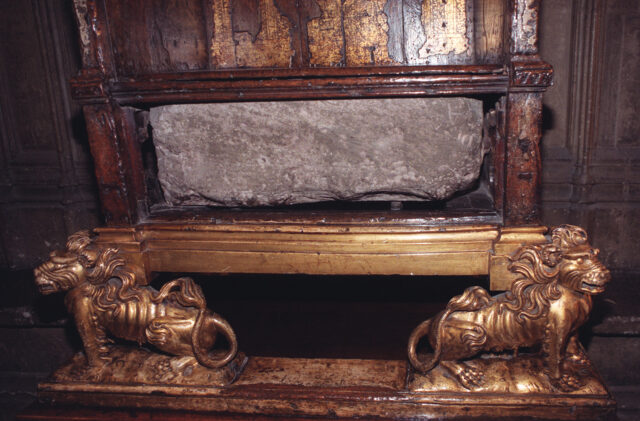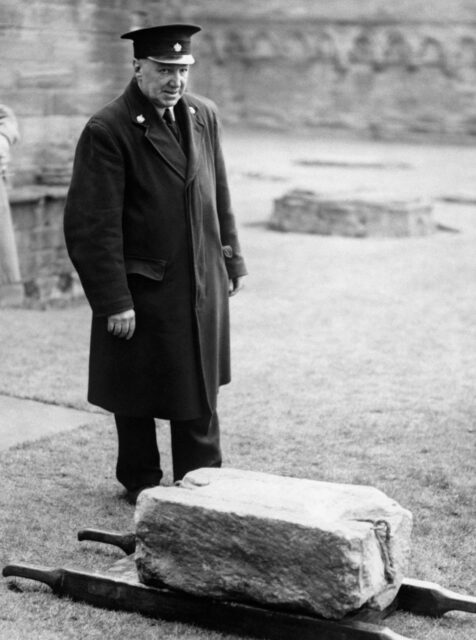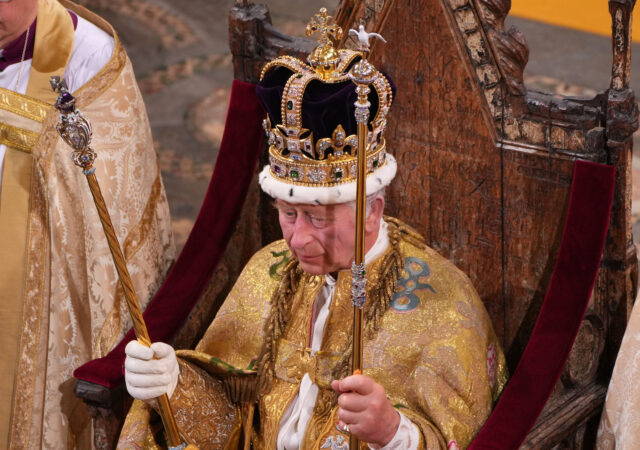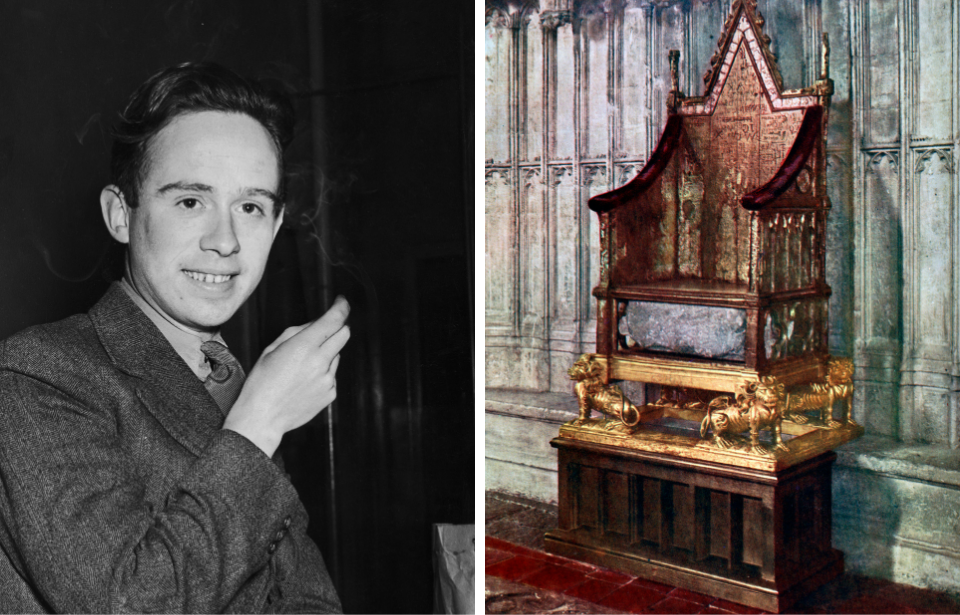The heist of the Stone of Destiny, also known as the Stone of Scone, was one of the most daring events in Scottish history. An ancient symbol of Scottish sovereignty, the stone was taken and kept in England for centuries. It eventually took four Scottish students to bring it back to home soil. The heist was a public sensation and captured the imagination of the Scottish people, who saw it as a symbol of their national pride and determination. Ultimately, the stone was returned to Westminster Abbey, but the theft remains a legendary episode in Scottish folklore.
The plan to steal the Stone of Destiny
The Stone of Destiny in Scone was used in the coronation of Scottish monarchs for hundreds of years. However, in 1296, the Stone was looted by King Edward I of England’s forces during the Scottish Wars of Independence. He had it moved to London, where it was fitted into a throne called the Coronation Chair. The stone served as a symbol that the monarchs of England would also be crowned as the rulers of Scotland, and King Edward I was declaring himself “King of Scots” with this act.

Centuries later, in 1950, four students at the University of Glasgow devised a plan to bring the stone back to Scotland. It’s believed that the inspiration to try and pull off such an endeavor was from Compton Mackenzie’s fiction novel, The North Wind of Love Bk. 1, published just six years earlier. The book, coupled with the spirit of Scottish devolution, made the liberation of the stone seem plausible to the students.
The heist involved students Ian Hamilton, Kay Matheson, Alan Stuart, and Gavin Vernon. It was funded by a Glasgow businessman named Robert Gray. A few days before Christmas, the four students set off for London in two Ford Anglias, stopping at Lyons Corner House when they first arrived in London following their 18-hour trip. During their stop, they had a meeting and decided they’d head to Westminster Abbey right away and make an immediate attempt to take the stone.
When they got to the Abbey, Hamilton hid under a trolley to try and make it past closing time but was caught by a night watchman. The watchman asked Hamilton what he was doing there after hours. He believed Hamilton’s story about getting locked in and eventually let him go. With their first plan foiled, the group of students would have to try again another day.
The stone broke in two
Their next attempt was on Christmas Eve. After discovering patterns in the nightwatchman’s shift, Hamilton, Vernon, and Stuart all entered the works yard at the Abbey at four o’clock in the morning, leaving Matheson to stay behind and watch the car. The students approached the entrance to Poet’s Corner and jimmied open the door, gaining entrance to the Abbey. Once inside, they made their way to the Chapel, where they set about removing the stone from the throne.

Sources differ on what happened next. Some say that once they were able to wedge the stone free from the chair, it fell to the floor and broke into two pieces. Others say that the men were able to get the stone to the ground in one piece, placing it on top of Hamilton’s coat to slide its 336 pounds across the floor. It was only after Hamilton grabbed the chains attached to the relic and pulled that the stone broke into two.
Either way, by the time they had removed the stone from the Abbey, it was in two pieces. Hamilton took the smaller half, which weighed about 90 pounds, out to the car where Matheson was waiting, leaving the other two to deal with the bigger section. At the same time, a policeman was approaching the parked vehicle. “Then, to my horror, I saw this policeman looking down the lane,” Matheson later said. “I realised if Ian crossed over to the car with the stone, the policeman was bound to see him. So I drew the car in as closely as I could and Ian quickly pushed the stone into the back seat of the car and threw a coat over it.”
The two pieces were separated
As soon as Hamilton entered the car, he and Matheson began passionately kissing in an attempt to make their presence less suspicious. The policeman interrupted and began conversing with Hamilton and Matheson, asking why they were parked in front of the Abbey at five o’clock in the morning when it was closed. They offered the excuse that they couldn’t find a hotel after having just arrived from Scotland, which he seemed to accept, and even shared in some jokes before he told them to move along. The policeman had no idea that they were driving away with half of the ancient relic in their car.

They began to drive toward Victoria, but during their journey, Hamilton got out of the car to walk back to the Abbey and help the others with the other half. However, Vernon and Stuart thought they’d been abandoned by the others and had fled the scene without the larger half of the stone. When Hamilton finally arrived back at the Abbey, he had to handle the heavier piece all by himself. He managed to drag it into the trunk of the second car. It was so heavy that it actually caused the Ford to sag.
On his journey back to Scotland, Hamilton saw Vernon and Stuart walking and picked them up. As the three continued to drive, they decided to hide the larger half of the stone in a field near Rochester in Kent before making their way home.
After she had stopped to let Hamilton out, Matheson continued with the smaller half of the stone to Birmingham, where she left the vehicle and the treasure it was hiding in the garage at a friend’s house. She then made her way back to Scotland by train.
English authorities sounded the alarms
Even though it hadn’t made its way to Scotland yet, the stone was officially missing from the Abbey. When authorities discovered that it was gone, they immediately closed the border between England and Scotland, for the first time in 400 years. Members of the Metropolitan Police and Scotland Yard were put on the case, and although they didn’t know it yet, they were correct in their suspicion that the stone was headed north.

It was Hamilton’s intention to leave the larger half of the stone in the field until the buzz around its theft had died down. However, his concern for the ancient relic out in the natural elements spurred him to travel with Stuart and two others to pick it up on New Year’s Eve. When they reached its location, they discovered that other people had gathered around the stone, but the students were successful in convincing them to help carry it to their car.
When the large piece of the stone finally made it back to Scotland, it was given to the Scottish Covenant Association and was hidden under the floorboards of a factory in Bonnybridge. When the smaller half was eventually brought up from Birmingham, a stonemason was hired to put the parts back together. Using copper tube doweling, he was able to make the two pieces whole again. The Scottish Covenant Association then took the repaired stone to a more remote location.
Ian Hamilton could not have been more relieved at the timing of handing the stone off, as suspicion had begun to fall on him surrounding its left. Detectives on the case discovered that Hamilton had taken out virtually all books involving the Stone of Destiny from a Glasgow library in the months prior to its disappearance. However, with the stone out of his hands, they couldn’t quite nail him for it.
The entire stone was eventually returned to England
After a few months, the Scottish Covenant Association decided it was time that the stone be returned. The successful execution of the heist had achieved its goal of raising awareness for the Scottish home rule movement. They left the stone at Arbroath Abbey, significant because it was the place where the historic Declaration of Scottish Independence was proclaimed in 1320.
In April 1951, the police received a tip that the stone was located there, and by February 1952, it had made its way back to Westminster Abbey.

All four students involved in the heist were questioned by police, and all but Hamilton confessed to being guilty. However, the motivation for their theft had the ability to create a highly politicized situation if they were to be reprimanded harshly. As such, they were not punished for their crime.
Sir Hartley Shawcross notably said in Parliament, “The clandestine removal of the Stone from Westminster Abbey, and the manifest disregard for the sanctity of the abbey, were vulgar acts of vandalism which have caused great distress and offence both in England and Scotland. I do not think, however, that the public interest required criminal proceedings to be taken.”
The heist made these four students heroes in the eyes of many, sparking feelings of pride throughout the country and opening up discussions about Scottish devolution.
Modern coronations

In 1953, the stone was used in the coronation of Queen Elizabeth II. Forty years later, in 1996, she decided that the stone should be returned to Scotland, where it is now housed at Edinburgh Castle. However, it was moved back to England and placed inside the Coronation Chair for the coronation of King Charles III in 2023.
Reflecting on the whole experience, Ian Hamilton once said in an interview, “The Stone of Destiny is Scotland’s icon. In one of the many invasions by the English into Scotland, they took away the symbol of our nation. To bring it back was a very symbolic gesture.”
More from us: The Irish Crown Jewels Have Been Missing for Over a Century – What Happened to Them?
“To do something for your country that spills not a drop of blood is, I think, something to be proud of,” Hamilton continued.
Let us know what you think in the comments below!
